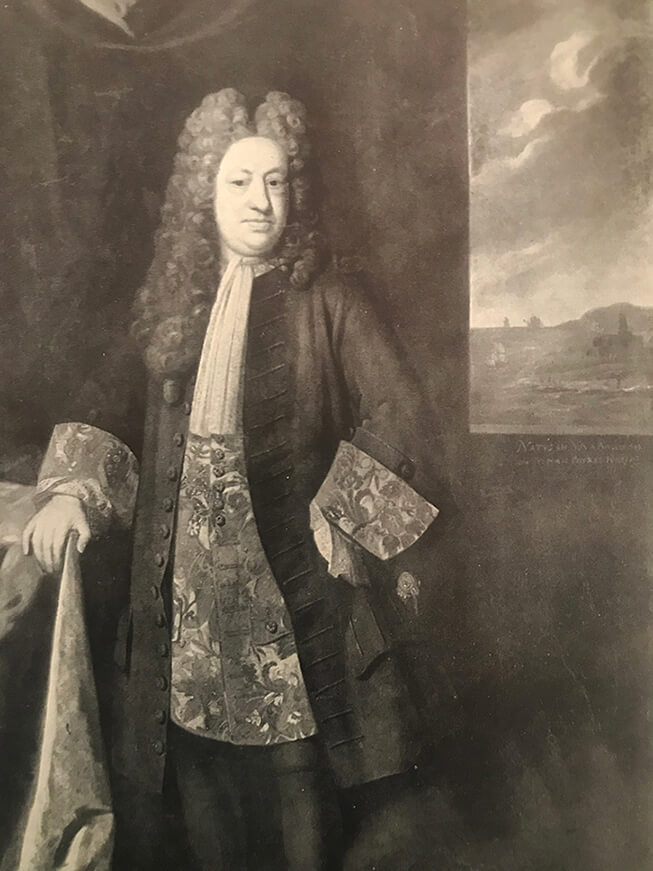Registered with the Registrar of Newspapers for India under R.N.I 53640/91
Vol. XXX No. 2, May 1-15, 2020
Lost Landmarks of Chennai
The first village of weavers
 Elihu Yale
Elihu YaleTo most of us researchers on the history of the city, Chintadripet is the best-known instance of the East India Company settling weavers in the vicinity of the Fort. The name of the area, as anyone with rudimentary knowledge of etymology will tell you, comes from Chinna Tari Pettah – the small locality of the looms. This was set up in 1735 or so, Governor George Morton Pitt being responsible for its creation. Two decades prior to it, a similar settlement of weavers was made, this being Colletspet, close to the village of Thiruvottriyur. Known today as Kaladipettai, it takes its name from Governor Joseph Collet, who set it up in collaboration with the Company’s writer Veeraraghava Brahminy, in 1717. It is more or less accepted as the first settlement of weavers from the hinterland in the vicinity of Madras that is Chennai. There were of course older villages of weavers close by, Mambalam being one that predates the Company.
Recent research however reveals that there was an earlier settlement, one made by Elihu Yale, when he was Governor of Madras between 1687 and 1692. It must rank as the first such attempt by the East India Company. Fort St George Consultation Records for the period reveal that on February 22, 1690, the Council granted a “cowle to Arlum Goorlingham and Paumer Raghua& C, fine weavers of the Janrawar Cast for their settlement and trade at Fort St. George.” The correct names of the two individuals mentioned is impossible to decipher now but it is safe to assume that they were representing their community of weavers. The location of the village however is not such a mystery for the cowle gives further details – “Proprietors hereof give and grant to the said Arlum Goorlingham Paumer Ragua, and to all other Weavers of the said Janrawar Cast with their families and c that are present here, or shall come hereafter, full liberty and freedome, to purchase build, and dwell in any part of the out town from the Janrawar Street as farr as the River, to the Westward and to the utmost of the Rt Honble Company’s limitts to the Northward.” (spelling as in original)
Fortunately for us, Janrawar Street referred to in the cowle is still standing, now known as Jandrayar Street. It is just south of Colletspet/Kaladipettai and to its west as mentioned in the company record, is the Buckingham Canal which follows the course of the earlier Elambore River. It is clear therefore that the settlement was around this street, and eventually was swallowed up in the larger development of Colletspet around 25 years later. From the fact that the name predates the settlement we can infer that some weavers were already here. Perhaps ArlumGoorlingham and his colleagues were from the same area. The Madras Census Report of 1906 identifies the Janrawar as “a caste of weavers inhabiting Canarese and Telugu districts.”
Company records reveal that this settlement by Yale had a family of fifty weavers and when they moved into the place there were other castes of weavers already living in the area. To prevent any clashes, the cowle stipulated dos and don’ts – The Janrawars were “to have full liberty to follow their said trade and calling, and to have the free exercise of their Religion with its ceremonyes as also all other formalityes and Solemnityes of the Countreymusick with dutyes fire works accustomary at feasts weddings and burials, or that are or have been used by any other Cast of Weavers formerly settled here provided the said ceremonies be only perform’d & acted within the said limitts from the said Janrawar Street, to the river and to our bounds to the Norward and noe where else to prevent difference with or offence to the other weavers or any other casts whatever.”
The records also speak of Yale ordering a large well to be built for use by the Janrawars at his cost and also “charge for a Land Mark or memoriall of these their Liberties and priviledges aforesaid.” There is no sign of any well in that area today and by landmark did the minutes mean a stone plaque bearing an edict of some kind? If so, that too has vanished.
The Governor at this time was at loggerheads with his council but this was one of those meetings where everyone was in agreement. Yale was a good negotiator and to ensure that weavers of other communities did not take umbrage over the bringing in of the Janrawars, used the occasion according to his biographer Hiram Bingham, to make “nice presents to the chiefs of other weaving castes: heavy cloth from England, rose water and betel. They promised to bring 1000 families of the several castes of weavers to work in Madras in their handicraft, which Governor Yale hoped would so increase that the town might be able to provide goods needed to be sent back to England.”
Whether that dream did materialize we do not know but Colletspet and Chintadripet were clearly in partial fulfillment of it.

